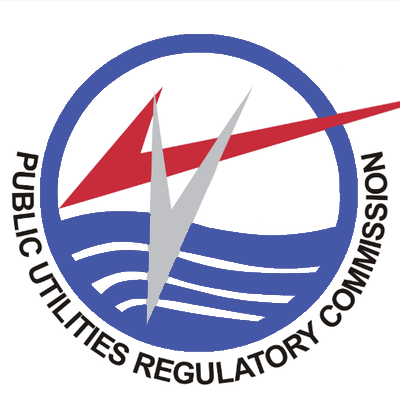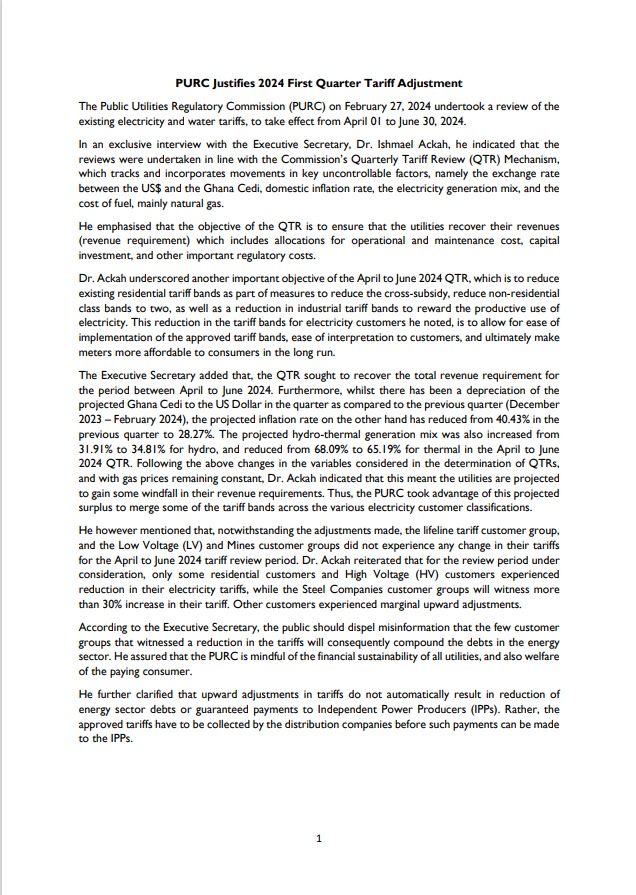PURC provides reasons for the decrease in electricity tariffs

The Public Utilities Regulatory Commission (PURC) has elucidated the reasoning behind the tariff adjustments for the initial quarter of 2024.
On February 28, the commission announced a marginal decrease in electricity tariffs for residential consumers, while maintaining current rates for lifeline consumers (0-30 kWh) and residential consumers utilizing 0-300 kWh.
PURC underscored that the slight tariff reduction of 6.56% would be advantageous to residential consumers utilizing more than 301 kWh.
In a statement released on March 5, PURC disclosed that it conducted a comprehensive review of existing electricity and water tariffs on February 27, 2024. The revised tariffs are set to take effect from April 01 to June 30, 2024. Dr. Ishmael Ackah, the Executive Secretary of PURC, emphasized that these reviews were conducted in accordance with the Commission’s Quarterly Tariff Review (QTR) Mechanism.
This mechanism monitors and integrates changes in key uncontrollable factors such as the US$ to Ghana Cedi exchange rate, domestic inflation rate, electricity generation mix, and fuel costs, particularly natural gas.
Dr. Ackah highlighted that the QTR aims to ensure utilities recover their revenues, encompassing allocations for operational and maintenance costs, capital investment, and other significant regulatory expenses.
Another pivotal objective of the QTR for April to June 2024 is to decrease existing residential tariff bands to mitigate cross-subsidization, reduce non-residential class bands to two, and lower industrial tariff bands to promote productive electricity use.
Dr. Ackah noted that these tariff band reductions aim to streamline the implementation and understanding of approved tariff bands, ultimately making meters more accessible for consumers.
He added that the QTR seeks to recuperate the total revenue requirement for the April to June 2024 period. Despite the depreciation of the projected Ghana Cedi to the US Dollar in the quarter compared to the previous one (December 2023 – February 2024), the anticipated inflation rate has decreased from 40.43% to 28.27%.
The projected hydro-thermal generation mix was adjusted from 31.91% to 34.81% for hydro, and from 68.09% to 65.19% for thermal in the QTR for April to June 2024.
Dr. Ackah indicated that these alterations, coupled with stable gas prices, imply that utilities are anticipated to experience a surplus in their revenue requirements.
Consequently, PURC utilized this anticipated surplus to consolidate some tariff bands across various electricity customer classifications.
Nevertheless, he clarified that despite these adjustments, the lifeline tariff customer group, and the Low Voltage (LV) and Mines customer groups witnessed no changes in their tariffs for the April to June 2024 tariff review period.
Dr. Ackah reiterated that only select residential customers and High Voltage (HV) customers observed a reduction in their electricity tariffs for the review period, while the Steel Companies customer groups will encounter over a 30% increase in their tariff. Other customers experienced slight upward adjustments.
He urged the public to disregard misinformation suggesting that the tariff reductions for certain customer groups will worsen debts in the energy sector.
He assured that PURC remains mindful of the financial sustainability of all utilities, as well as the welfare of paying consumers.
Furthermore, he clarified that upward adjustments in tariffs do not automatically translate to reductions in energy sector debts or assured payments to Independent Power Producers (IPPs). Instead, the approved tariffs must be collected by the distribution companies before such payments can be facilitated to the IPPs.





